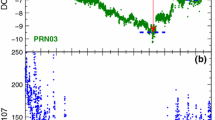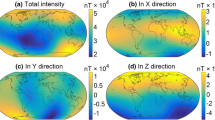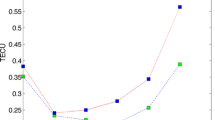Abstract
Based on the analysis of the satellite DCB data estimated by our method and the Center for Orbit Determination in Europe (CODE) from 1999 to 2011, the features of the temporal variation of differential code biases (DCB) are studied. Summarily, there are three types of variations in DCB on different time scales. The first one is the day-to-day variation that exhibits more obviously in solar maximum years. The second one is the variation with about one year periodic variation that behaves more obviously from 1999 to 2004. The last one is the monotonously descending tendency from 1999 to 2010. Considering the basic ionospheric approximation in DCB estimation method, the features of the variability of the ionospheric morphology from 1999 to 2010 are also displayed based on the ionospheric characteristic parameters. It can be concluded that the day-to-day and annual variation of the estimated global positioning system (GPS). DCB is related to the ionospheric variability. The variation of DCBs on solar cycle time scale includes the real hardware DCBs and pseudo-DCBs induced by ionospheric variation. No doubt, these kinds of “pseudo” variations of DCB will affect the precision of ionospheric total electron content (TEC) derived from the GPS data. In addition, this study is helpful for evaluating the influence of ionospheric weather on TEC derivation and is also useful for developing one estimation method of DCB with more stability and precision through introducing a more practical ionospheric model.
Similar content being viewed by others
References
Lanyi G E, Roth T. A comparison of mapped and measured total ionospheric electron content using global positioning system and beacon satellite observations. Radio Sci, 1988, 23: 483–492
Ciraolo L. Evaluation of GPS L2-L1 biases and related daily TEC profiles. Proceedings of the GPS/Ionosphere Workshop, Neustrelitz, 1993. 90–97
Ciraolo L, Azpilicueta F, Brunini C, et al. Calibration errors on experimental slant total electron content (TEC) determined with GPS. J Geod, 2007, 81: 111–120
Brunini C, Meza A, Bosch W. Temporal and spatial variability of the bias between TOPEX and GPS-derived total electron conten. J Geod, 2005, 79: 175–188
Lilensten J, Canderb Lj.R. Calibration of the TEC derived from GPS measurements and from ionospheric models using the EISCAT radar. J Atmos Sol-Terr Phys, 2003: 833–842
Lunt N, Kersley L, Bishop G J, et al. The effect of the protonosphere on the estimation of GPS total electron content validation using model simulations. Radio Sci, 1999, 34: 1261–1271
Sekido M, Kondo T, Kawai E, et al. Evaluation of GPS-based ionospheric TEC map by comparing with VLBI data. Radio Sci, 2003, 38, 1069, doi: 10.1029/2000RS002620
Vladimer J A, Lee M C, Doherty P H, et al. Comparisons of TOPEX and Global Positioning System total electron content measurements at equatorial anomaly latitudes. Radio Sci, 1997, 32: 2209–2220
Zhang W, Zhang D H, and Xiao Z. The influence of geomagnetic storms on the estimation of GPS instrumental biases. Ann. Geophys., 2009, 27, 1613C1623, doi: 10.5194/angeo-27-1613-2009
Zhang D H, Zhang W, Li Q, et al. Accuracy analysis of the GPS instrumental bias estimated from observations in middle and low latitudes. Ann Geophys, 2010, 28, 1571C1580, doi:10.5194/angeo-28-1571-2010
Jee G, Lee H B, Kim Y H, et al. Assessment of GPS global ionosphere maps (GIM) by comparison between CODE GIM and TOPEX/Jason TEC data: Ionospheric perspective, J. Geophys. Res, 2010, 115, A10319, doi: 10.1029/2010JA015432
Mannucci A J, Wilson B D, Yuan D N, et al. A global mapping technique for GPS derived ionospheric total electron content measurements. Radio Sci, 1998, 33: 565–582
Zhang D H, Xiao Z. The calculating TEC methods by using GPS observations and their applications for ionospheric disturbances. Chin. J. Geophys., 2000, 43: 451–458
Arikan F, Nayir H, Sezen Z, et al. Estimation of single station interfrequency receiver bias using GPS-TEC, Radio Sci., 2008, 43, RS4004, doi: 10.1029/2007RS003785
Hernández-Pajares M J, Juan M, Sanz J, et al. The IGS VTEC maps: A reliable source of ionospheric information since 1998, J Geod, 2009, 83: 263–275, DOI 10.1007/s00190-008-0266-1
Dyrud L, Jovancevic A, Brown A, et al. Ionospheric measurement with GPS: Receiver techniques and methods, Radio Sci, 2008, 43, RS6002, doi: 10.1029/2007RS003770
LI Q, Feng M, Zhang D H, et al. Methods of estimation of GPS instrumental bias from single site’s GPS data and comparative study of results. Acta Scientiarum Naturalium Universitatis Pekinensis, 2008, 44: 159–156
Ma X F, Maruyama T, Ma G, et al. Determination of GPS receiver differential biases by neural network parameter estimation method, Radio Sci, 2005, 40, RS1002, doi: 10.1029/2004RS003072
Lunt N, Kersley L, Bishop G J, et al. The contribution of the protonosphere to GPS total electron content: Experimental measurements, Radio Sci, 1999, 34: 1273–1280, doi: 10.1029/1999RS900016
Coco D S, Coker C, Dahlke, et al. Variability of GPS satellite differential group delay biases, IEEE T. Aero. Elec. Sys, 1991, 27: 931C938
Sardon E. and Zarraoa N. Estimation of total electron content using GPS data: How stable are the differential satellite and receiver instrumental biases. Radio Sci, 1997, 32: 1899C1910
Liu Z Z, Gao Y. Ionospheric TEC predictions over a local area GPS reference network. GPS Solut, 2004, 8: 23C29
Ma G, Maruyama, T. Derivation of TEC and estimation of instrumental biases from GEONET in Japan, Ann. Geophys, 2003, 21, 2083C2093, doi: 10.5194/angeo-21-2083-2003
Otsuka Y, Ogawa T, Saito, et al. A new technique for mapping of total electron content using GPS network in Japan. Earth Planets Space, 2002, 54: 63C70
Rishbeth H, Mendilloa M. Patterns of F2-layer variability, J Atmos Sol-Terr Phys, 2001, 63: 1661C1680
Rama Rao P V S, Niranjan K, Prasad D S V V D, et al. On the validity of the ionospheric pierce point (IPP) altitude of 350 km in the Indian equatorial and low-latitude sector. Ann Geophys 2006, 24: 2159–2168
Wilson J W, Kim M H Y, Shinn J L, et al. Solar cycle variation and application to the space radiation environment. NASA/TP-1999-209369, 1999
Author information
Authors and Affiliations
Corresponding author
Rights and permissions
About this article
Cite this article
Zhang, D., Shi, H., Jin, Y. et al. The variation of the estimated GPS instrumental bias and its possible connection with ionospheric variability. Sci. China Technol. Sci. 57, 67–79 (2014). https://doi.org/10.1007/s11431-013-5419-7
Received:
Accepted:
Published:
Issue Date:
DOI: https://doi.org/10.1007/s11431-013-5419-7




